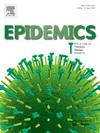中国成都猩红热传播动态和社会经济决定因素建模:综合SEIAR和机器学习方法
IF 2.4
3区 医学
Q2 INFECTIOUS DISEASES
引用次数: 0
摘要
背景:猩红热(SF)是一种急性传染病,对公共卫生构成重大威胁;然而,其传播动态,特别是无症状携带者和社会经济决定因素的影响仍不清楚。方法建立纳入无症状感染的易感-暴露-感染-无症状恢复(SEIAR)模型,利用当地流行病学数据估计2005-2019年成都市SF的时变繁殖数(Rt)。采用决定系数(R²)对模型进行评价,敏感性分析证实了模型的稳健性。结果2005 - 2019年,成都市共报告SF病例11499例,平均发病率为4.87 / 10万。4 - 5月和11 - 12月出现两个明显的季节性高峰,学校假期期间发病率明显较低。大多数病例影响3至7岁儿童,男女比例为1.59:1。武侯市、新都等核心区发病率最高。SEIAR模型显示出较强的预测性能(总体R²= 0.831,P <; 0.001),估计中位Rt为0.963;然而,一些地区超过了这一阈值,在发病率激增前大约两个月,Rt达到峰值。综合社会经济分析发现,独生子女率是影响Rt的主要因素,其次是人口密度和医疗机构密度(P <; 0.01)。结论将流行病学数据与社会经济因素相结合,定量阐明了成都市SF的传播特征,为缺乏疫苗接种情况下的监测和有针对性的干预策略提供数据驱动支持。本文章由计算机程序翻译,如有差异,请以英文原文为准。
Modeling transmission dynamics and socio-economic determinants of scarlet fever in Chengdu, China: An integrated SEIAR and machine learning approach
Background
Scarlet fever (SF) is an acute infectious disease that poses a significant public health threat; however, its transmission dynamics, particularly the impact of asymptomatic carriers and socioeconomic determinants, remain unclear.
Methods
We developed a susceptible–exposed–infectious–asymptomatic–recovered (SEIAR) model that incorporates asymptomatic infections to estimate the time-varying reproduction number (Rt) for SF in Chengdu (2005–2019) using local epidemiological data. The model was evaluated using the coefficient of determination (R²), and sensitivity analysis confirmed its robustness. We further integrated Boruta, Extreme Gradient Boosting (XGBoost), and SHapley Additive exPlanations (SHAP) to systematically assess the influence of socioeconomic variables on Rt.
Results
Between 2005 and 2019, Chengdu reported 11,499 cases of SF, with an average incidence of 4.87 per 100,000. Two distinct seasonal peaks occurred in April–May and November–December, and incidence rates were notably lower during school holidays. The majority of cases affected children aged 3–7, with a male-to-female ratio of 1.59:1. In addition, core districts such as Wuhou and Xindu exhibited the highest incidence. The SEIAR model demonstrated strong predictive performance (overall R² = 0.831, P < 0.001) and estimated a median Rt of 0.963; however, several regions exceeded this threshold, with Rt peaking approximately two months prior to incidence surges. Spatial analyses revealed significant clustering in central urban areas, and integrated socioeconomic analysis identified the one-child rate as the primary driver of Rt, followed by population density and healthcare facility density (P < 0.01).
Conclusion
By integrating epidemiological data with socioeconomic factors, this study quantitatively elucidates the transmission characteristics of SF in Chengdu, providing data-driven support for monitoring and targeted intervention strategies in the absence of vaccination.
求助全文
通过发布文献求助,成功后即可免费获取论文全文。
去求助
来源期刊

Epidemics
INFECTIOUS DISEASES-
CiteScore
6.00
自引率
7.90%
发文量
92
审稿时长
140 days
期刊介绍:
Epidemics publishes papers on infectious disease dynamics in the broadest sense. Its scope covers both within-host dynamics of infectious agents and dynamics at the population level, particularly the interaction between the two. Areas of emphasis include: spread, transmission, persistence, implications and population dynamics of infectious diseases; population and public health as well as policy aspects of control and prevention; dynamics at the individual level; interaction with the environment, ecology and evolution of infectious diseases, as well as population genetics of infectious agents.
 求助内容:
求助内容: 应助结果提醒方式:
应助结果提醒方式:


